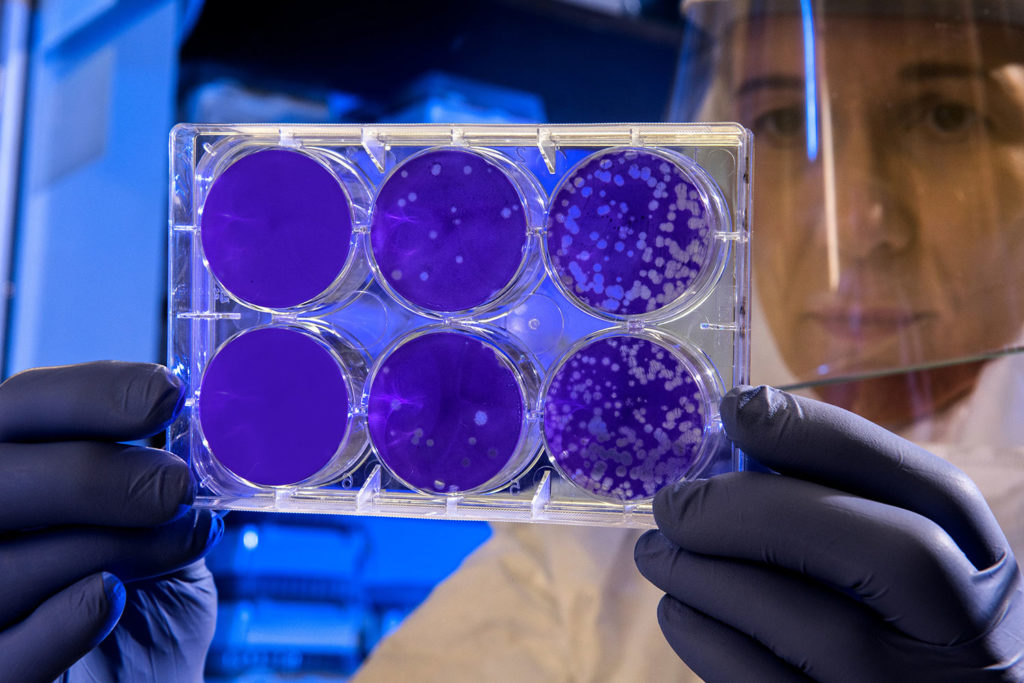By Walter Bradley
Introduction
Antony Flew, a British philosophy professor and leading champion of atheism for more than half a century, changed his mind and became a deist at the age of 81. In a telephone interview with ABC News (12/9/2004), Flew indicated that a “super-intelligence is the only good explanation for the origin of life and the complexity of nature.” Nicholas Wade in the New York Times (6/13/2000) summarized the current state of the affairs regarding the origin of life as follows: “The chemistry of the first life is a nightmare to explain. No one has yet developed a plausible explanation to show how the earliest chemicals of life—thought to be RNA—might have constructed themselves from the inorganic chemicals likely to have been around on early earth. The spontaneous assembly of a small RNA molecule on the primitive earth ‘would have been a near miracle’ two experts on the subject helpfully declared last year.” What is it about the origin of life that has so confounded scientists and persuaded atheists to become deists or theist? Why is the origin of life considered one of the “great, unsolved mysteries of science” (Discover 1993)?
The minimal functional requirements for a living system include processing energy, storing information, and replicating. Lila Gatlin captures the essence of the problem by noting that life may be defined operationally as an informational processing system that has the ability to store and process information that is essential for its own reproduction. These biological operations are made possible by very complex molecules such as DNA, RNA, and protein. In this essay, I would like explore the “miracle of the origin of life” by providing on overview of the molecular complexity that is essential to life and by indicating why it is so difficult for unguided natural laws, sometimes characterized as chance and necessity, to ever adequately account for the origin of these remarkable molecules of life.
Information and the Molecules of Life
Protein, RNA, and DNA are all long polymer chains. The “mer” in “polymer” means building block and “poly” means many. The protein molecule is a polymer typically composed of 100 to 300 smaller molecular building blocks (or mers) called amino acids. There are 20 distinct types of amino acid building blocks in protein. These amino acids chemically react to form long polymer chains, which subsequently folds up into a three dimensional structures. It is this distinctive structure that allows various proteins to serve as catalysts, making chemical reactions in living systems go a million times more rapidly.
The sequencing of the twenty different kinds of amino acids is what determines the three dimensional structure. Only a very, very small fraction of the possible sequences of amino acids give three dimensional structures that have any biological utility. In fact it has been predicted theoretically and confirmed experimentally that the probability of getting the correct sequence of amino acids for a protein such as cytochrome C is approximately 1 in 1060. How then are proteins ever successfully assembled from amino acids in living cells?
The DNA and RNA molecules are the key to getting the remarkable sequences of amino acids in proteins that provide critical biological functions in living cells. The DNA is encoded with information that can be used to sequence the amino acids in various proteins for a given organism. The m-RNA molecule receives this encoded information from the DNA and then serves as a template to get exactly the right sequencing of amino acids to give over 300 distinct functional proteins. We may think of the DNA as the “computer brain” for each cell, controlling the sequencing of amino acids in 300 or more distinctive proteins, which in turn control the necessary chemistry of life in the cell. To make a DNA molecule with the right encoded information for E-coli bacteria would require 4,600,000 instructions for the chemist, or the equivalent of 800 pages of information. So while this solves the problem of the origin of the necessary information to sequence (or encode) various proteins, it does not solve the mystery of the origin of this huge amount of information, but merely transfers it back to the DNA (or possibly RNA in the first living system). The origin of the large amount of information in DNA that is expressed in the amazing molecular complexity essential for life is the central enigma of the origin of life.
Making DNA, RNA and Protein under Prebiotic Conditions
DNA molecules reproduce themselves (with the help of proteins) and, assisted by RNA, encode the various amino acid sequences in proteins that make possible the efficient uses of energy in living systems. Thus, DNA, RNA and protein provide the necessary functions of life: namely, information storage, replication, and efficient utilization of energy. But how were the first DNA, RNA and protein produced? Origin of life research for more than 50 years has tried to answer this question? What have we learned?
Origin of life research began in the 1950s with the attempt to chemically synthesize the basic molecular building blocks for protein and DNA, including various amino acids, bases, and sugars. The early success of Miller and Urey in making these molecular building blocks, ostensibly under early earth conditions, was seriously undercut in the 1980s when it was determined that the early earth’s atmosphere was never rich in methane, ammonia. or hydrogen, the chemical gases used in their experiments. One cannot produce more than minuscule yields of amino acids and ribose sugar when one uses a plausible prebiotic chemistry. Today the origin of these essential building blocks of life remains a mystery.
A second problem is that the building blocks on the prebiotic earth would have been surrounded by many other chemical reagents that react with the building blocks much more quickly than they react with each other. Unless such destructive cross reactions could somehow be avoided, the emergence of DNA, RNA or protein would be impossible.
A third problem is the assembly of the building blocks into the polymer chains. For example, amino acids can be joined (in chemical reactions) in a variety of ways, but only one type of joining of adjacent amino acid molecules (i.e., chemical bonds called peptide) give a polymer chain that has the function of a protein. In a similar way, 3-5 phosphodiester linkages are needed but 2-5 linkages dominate in the polymerization of polynucleotides, which is a primary step in the formation of DNA and RNA.
A fourth challenge results from the fact that amino acids and sugars come in right-handed or left-handed versions (structures that are identical except that they are mirror images). All amino acids chemically react equally with each version equally rapidly, but living systems have only L-amino acids and D-sugars. How could we possibly get 100 or more amino acids that are all Ls from a mixture of equal concentrations of Ls and Ds? This problem has been studied extensively but the explanation remains elusive.
Beyond the problems of producing the building blocks under plausible prebiotic conditions, avoiding fatal cross chemical reactions and getting the building blocks assembled, getting on L amino acids or D sugars, the most challenging problem in the origin of life scenario is how to get the correct sequencing of amino acids in proteins and the correct sequencing of bases in DNA to give information that can provide biological function. As previously noted, the information encoded on the DNA of E-coli bacteria is the equivalent of 800 pages of information. While it is sometime argued that this can happen with some kind of chemical selection over time, no selection is possible on molecular systems that do not yet have the capacity to replicate with occasional mistakes and provide functions that give selective advantage. Functional DNA, RNA or protein might be able to incrementally improve with replication mistakes acted upon by selection, but this is meaningless in molecules that are not yet sufficiently complex as to provide at least minimal function. It is the molecular version of the old problem of which came first, the chicken or the egg.
Summary
Michael Behe has argued that there are irreducibly complex hurdles that an evolutionary process driven by natural selection cannot overcome —for example, the concurrent development of a multiple component system that provides no selective advantage until each of the components has developed to a rather advanced level and can function together as a system. The origin of life would seem to be the quiescent example of an irreducibly complex hurdle in the meta-narrative of the origin and development of living systems. The necessary information, which expresses itself as molecular complexity, simply cannot be developed by chance and necessity but requires an intelligent cause, an intelligent designer, a Creator God.
Walter L. Bradley is a retired professor of materials science and engineering. His work has focused on the mechanical properties of polymeric composites and engineering plastics, emphasizing fracture mechanics and life prediction. His research has been supported by NSF, DOE, NASA, AFOSR and many Fortune 500 companies including Dupont, Dow Chemical, 3M and Chevron-Phillips resulting in more than 130 refereed articles and 12 book chapters. In recognition of his contributions to his field, he was elected Fellow of the American Society for Materials in 1993 and Educator of the Year for the Society of Plastics Engineering in 2011. He has co-authored several seminal works on the origin of life, including an article in “Debating Design: From Darwin to DNA” (edited by William Dembski and Michael Ruse) and the book The Mystery of Life’s Origin, originally published by Philosophical Library. To this day, Mystery remains the best-selling advanced level text on the origin of life.
Published March 30, 2016




